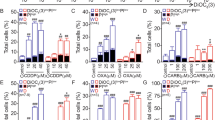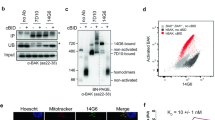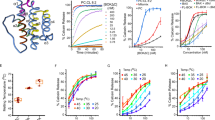Abstract
The pro-apoptotic BCL-2 family member BOK is widely expressed and resembles the multi-BH domain proteins BAX and BAK based on its amino acid sequence. The genomic region encoding BOK was reported to be frequently deleted in human cancer and it has therefore been hypothesized that BOK functions as a tumor suppressor. However, little is known about the molecular functions of BOK. We show that enforced expression of BOK activates the intrinsic (mitochondrial) apoptotic pathway in BAX/BAK-proficient cells but fails to kill cells lacking both BAX and BAK or sensitize them to cytotoxic insults. Interestingly, major portions of endogenous BOK are localized to and partially inserted into the membranes of the Golgi apparatus as well as the endoplasmic reticulum (ER) and associated membranes. The C-terminal transmembrane domain of BOK thereby constitutes a ‘tail-anchor’ specific for targeting to the Golgi and ER. Overexpression of full-length BOK causes early fragmentation of ER and Golgi compartments. A role for BOK on the Golgi apparatus and the ER is supported by an abnormal response of Bok -deficient cells to the Golgi/ER stressor brefeldin A. Based on these results, we propose that major functions of BOK are exerted at the Golgi and ER membranes and that BOK induces apoptosis in a manner dependent on BAX and BAK.
Similar content being viewed by others
Log in or create a free account to read this content
Gain free access to this article, as well as selected content from this journal and more on nature.com
or
Abbreviations
- 4-OHT:
-
4-hydroxytamoxifen
- BFA:
-
brefeldin A
- BH:
-
BCL-2 homology
- BOK:
-
BCL-2-related ovarian killer
- BIM:
-
BCL-2-interacting mediator of cell death
- ER:
-
endoplasmic reticulum
- GRP78 (BiP):
-
glucose-regulated protein 78 (binding protein)
- GM130:
-
Golgi matrix 130
- MAM:
-
mitochondria-associated membrane
- IRE1α:
-
inositol requiring kinase and endonuclease 1 alpha
- MCL-1:
-
myeloid-cell leukemia sequence 1
- MOMP:
-
mitochondrial outer membrane permeabilization
- TMD:
-
transmembrane domain
References
Youle RJ, Strasser A . The BCL-2 protein family: opposing activities that mediate cell death. Nat Rev Mol Cell Biol 2008; 9: 47–59.
Schinzel A, Kaufmann T, Borner C . Bcl-2 family members: integrators of survival and death signals in physiology and pathology [corrected]. Biochim Biophys Acta 2004; 1644: 95–105.
Adams JM, Cory S . Life-or-death decisions by the Bcl-2 protein family. Trends Biochem Sci 2001; 26: 61–66.
Giam M, Huang DC, Bouillet P . BH3-only proteins and their roles in programmed cell death. Oncogene 2008; 27 (Suppl 1): S128–S136.
Chipuk JE, Moldoveanu T, Llambi F, Parsons MJ, Green DR . The BCL-2 family reunion. Mol Cell 2010; 37: 299–310.
Shamas-Din A, Brahmbhatt H, Leber B, Andrews DW . BH3-only proteins: orchestrators of apoptosis. Biochim Biophys Acta 2011; 1813: 508–520.
Pop C, Salvesen GS . Human caspases: activation, specificity, and regulation. J Biol Chem 2009; 284: 21777–21781.
Riedl SJ, Shi Y . Molecular mechanisms of caspase regulation during apoptosis. Nat Rev Mol Cell Biol 2004; 5: 897–907.
Borgese N, Fasana E . Targeting pathways of C-tail-anchored proteins. Biochim Biophys Acta 2011; 1808: 937–946.
Szegezdi E, Macdonald DC, Ni Chonghaile T, Gupta S, Samali A . Bcl-2 family on guard at the ER. Am J Physiol Cell Physiol 2009; 296: C941–C953.
Kaufmann T, Schlipf S, Sanz J, Neubert K, Stein R, Borner C . Characterization of the signal that directs Bcl-xL, but not Bcl-2, to the mitochondrial outer membrane. J Cell Biol 2003; 160: 53–64.
Heath-Engel HM, Shore GC . Regulated targeting of Bax and Bak to intracellular membranes during apoptosis. Cell Death Differ 2006; 13: 1277–1280.
Heath-Engel HM, Chang NC, Shore GC . The endoplasmic reticulum in apoptosis and autophagy: role of the BCL-2 protein family. Oncogene 2008; 27: 6419–6433.
Rong YP, Aromolaran AS, Bultynck G, Zhong F, Li X, McColl K et al. Targeting Bcl-2-IP3 receptor interaction to reverse Bcl-2's inhibition of apoptotic calcium signals. Molecular Cell 2008; 31: 255–265.
Hacki J, Egger L, Monney L, Conus S, Rosse T, Fellay I et al. Apoptotic crosstalk between the endoplasmic reticulum and mitochondria controlled by Bcl-2. Oncogene 2000; 19: 2286–2295.
Hsu SY, Kaipia A, McGee E, Lomeli M, Hsueh AJ . Bok is a pro-apoptotic Bcl-2 protein with restricted expression in reproductive tissues and heterodimerizes with selective anti-apoptotic Bcl-2 family members. Proc Natl Acad SciUSA 1997; 94: 12401–12406.
Inohara N, Ekhterae D, Garcia I, Carrio R, Merino J, Merry A et al. Mtd, a novel Bcl-2 family member activates apoptosis in the absence of heterodimerization with Bcl-2 and Bcl-xL. J Biol Chem 1998; 273: 8705–8710.
Gao S, Fu W, Durrenberger M, De Geyter C, Zhang H . Membrane translocation and oligomerization of hBok are triggered in response to apoptotic stimuli and Bnip3. Cell Mol Life Sci 2005; 62: 1015–1024.
Zhang H, Holzgreve W, De Geyter C . Evolutionarily conserved Bok proteins in the Bcl-2 family. FEBS Lett 2000; 480: 311–313.
Ke F, Voss A, Kerr JB, O'Reilly LA, Tai L, Echeverry N et al. BCL-2 family member BOK is widely expressed but its loss has only minimal impact in mice. Cell Death Differ 2012; 19: 915–925.
Bartholomeusz G, Wu Y, Ali Seyed M, Xia W, Kwong KY, Hortobagyi G et al. Nuclear translocation of the pro-apoptotic Bcl-2 family member Bok induces apoptosis. Mol Carcinog 2006; 45: 73–83.
Yakovlev AG, Di Giovanni S, Wang G, Liu W, Stoica B, Faden AI . BOK and NOXA are essential mediators of p53-dependent apoptosis. J Biol Chem 2004; 279: 28367–28374.
Hsu SY, Hsueh AJ . A splicing variant of the Bcl-2 member Bok with a truncated BH3 domain induces apoptosis but does not dimerize with antiapoptotic Bcl-2 proteins in vitro. J Biol Chem 1998; 273: 30139–30146.
Rodriguez JM, Glozak MA, Ma Y, Cress WD . Bok, Bcl-2-related ovarian killer, is cell cycle-regulated and sensitizes to stress-induced apoptosis. J Biol Chem 2006; 281: 22729–22735.
Lindsten T, Ross AJ, King A, Zong W, Rathmell JC, Shiels HA et al. The combined functions of proapoptotic Bcl-2 family members Bak and Bax are essential for normal development of multiple tissues. Mol Cell 2000; 6: 1389–1399.
Rathmell JC, Lindsten T, Zong W-X, Cinalli RM, Thompson CB . Deficiency in Bak and Bax perturbs thymic selection and lymphoid homeostasis. Nat Immunol 2002; 3: 932–939.
Beroukhim R, Mermel CH, Porter D, Wei G, Raychaudhuri S, Donovan J et al. The landscape of somatic copy-number alteration across human cancers. Nature 2010; 463: 899–905.
Wei MC, Zong WX, Cheng EH, Lindsten T, Panoutsakopoulou V, Ross AJ et al. Proapoptotic BAX and BAK: a requisite gateway to mitochondrial dysfunction and death. Science 2001; 292: 727–730.
Vince JE, Wong WW, Khan N, Feltham R, Chau D, Ahmed AU et al. IAP antagonists target cIAP1 to induce TNFalpha-dependent apoptosis. Cell 2007; 131: 682–693.
Dewson G, Kratina T, Sim HW, Puthalakath H, Adams JM, Colman PM et al. To trigger apoptosis, Bak exposes its BH3 domain and homodimerizes via BH3:groove interactions. Mol Cell 2008; 30: 369–380.
Zha HB, Reed JC . Heterodimerization-independent functions of cell death regulatory proteins Bax and Bcl-2 in yeast and mammalian cells. J Biol Chem 1997; 272: 31482–31488.
Kuroda R, Ikenoue T, Honsho M, Tsujimoto S, Mitoma JY, Ito A . Charged amino acids at the carboxyl-terminal portions determine the intracellular locations of two isoforms of cytochrome b5. J Biol Chem 1998; 273: 31097–31102.
Horie C, Suzuki H, Sakaguchi M, Mihara K . Characterization of signal that directs c-tail-anchored proteins to mammalian mitochondrial outer membrane. Mol Biol Cell 2002; 13: 1615–1625.
Lithgow T, van Driel R, Bertram JF, Strasser A . The protein product of the oncogene bcl-2 is a component of the nuclear envelope, the endoplasmic reticulum and the outer mitochondrial membrane. Cell Growth Differ 1994; 5: 411–417.
Gotow T, Shibata M, Kanamori S, Tokuno O, Ohsawa Y, Sato N et al. Selective localization of Bcl-2 to the inner mitochondrial and smooth endoplasmic reticulum membranes in mammalian cells. Cell Death Differ 2000; 7: 666–674.
Lisauskas T, Matula P, Claas C, Reusing S, Wiemann S, Erfle H et al. Live-cell assays to identify regulators of ER-to-Golgi trafficking. Traffic 2012; 13: 416–432.
Scorrano L, Oakes SA, Opferman JT, Cheng EH, Sorcinelli MD, Pozzan T et al. BAX and BAK regulation of endoplasmic reticulum Ca2+: a control point for apoptosis. Science 2003; 300: 135–139.
Zong WX, Li C, Hatzuvassiliou G, Lindsten T, Yu QC, Yuan J et al. Bax and Bak can localize to the endoplasmic reticulum to initiate apoptosis. J Cell Biol 2003; 162: 59–69.
Hetz C . The unfolded protein response: controlling cell fate decisions under ER stress and beyond. Nat Rev Mol Cell Biol 2012; 13: 89–102.
Zhang H, Huang Q, Ke N, Matsuyama S, Hammock B, Godzik A et al. Drosophila pro-apoptotic Bcl-2/Bax homologue reveals evolutionary conservation of cell death mechanisms. J Biol Chem 2000; 275: 27303–27306.
Dewson G, Kratina T, Czabotar P, Day CL, Adams JM, Kluck RM . Bak activation for apoptosis involves oligomerization of dimers via their alpha6 helices. Mol Cell 2009; 36: 696–703.
Zha H, Reed JC . Hetereodimerization-independent functions of cell death regulatory proteins Bax and Bcl-2 in yeast and mammalian cells. J Biol Chem 1997; 272: 31482–31488.
He H, Lam M, McCormick TS, Distelhorst CW . Maintenance of calcium homeostasis in the endoplasmic reticulum by Bcl-2. J Cell Biol 1997; 138: 1219–1228.
Thomenius MJ, Wang NS, Reineks EZ, Wang Z, Distelhorst CW . Bcl-2 on the endoplasmic reticulum regulates Bax activity by binding to BH3 only proteins. J Biol Chem 2003; 278: 6243–6250.
Hetz C, Bernasconi P, Fisher J, Lee AH, Bassik MC, Antonsson B et al. Proapoptotic BAX and BAK modulate the unfolded protein response by a direct interaction with IRE1alpha. Science 2006; 312: 572–576.
Rusinol AE, Cui Z, Chen MH, Vance JE . A unique mitochondria-associated membrane fraction from rat liver has a high capacity for lipid synthesis and contains pre-Golgi secretory proteins including nascent lipoproteins. J Biol Chem 1994; 269: 27494–27502.
Puthalakath H, O'Reilly LA, Gunn P, Lee L, Kelly PN, Huntington ND et al. ER stress triggers apoptosis by activating BH3-only protein Bim. Cell 2007; 129: 1337–1349.
Ray JE, Garcia J, Jurisicova A, Caniggia I . Mtd/Bok takes a swing: proapoptotic Mtd/Bok regulates trophoblast cell proliferation during human placental development and in preeclampsia. Cell Death Differ 2009; 17: 846–859.
Egger L, Schneider J, Rheme C, Tapernoux M, Hacki J, Borner C . Serine proteases mediate apoptosis-like cell death and phagocytosis under caspase-inhibiting conditions. Cell Death Differ 2003; 10: 1188–1203.
Walter D, Schmich K, Vogel S, Pick R, Kaufmann T, Hochmuth FC et al. Switch from type II to I Fas/CD95 death signaling on in vitro culturing of primary hepatocytes. Hepatology 2008; 48: 1942–1953.
Rosner M, Hengstschlager M . Cytoplasmic and nuclear distribution of the protein complexes mTORC1 and mTORC2: rapamycin triggers dephosphorylation and delocalization of the mTORC2 components rictor and sin1. Hum Mol Genet 2008; 17: 2934–2948.
Grabenbauer M, Geerts WJ, Fernadez-Rodriguez J, Hoenger A, Koster AJ, Nilsson T . Correlative microscopy and electron tomography of GFP through photooxidation. Nat Methods 2005; 2: 857–862.
Acknowledgements
This study was performed with the support of the Microscopy Imaging Center (MIC), University of Bern. We thank Grant Dewson (Melbourne, Australia) for discussions and critical comments on the manuscript; Shida Yousefi (Bern, CH) for help with microscopy; John Silke (Melbourne, Australia) for the lentiviral-inducible expression system; Mario Tschan (Bern, CH) for the CAD-G-Whiz lentiviral vector; Nadia Corazza and Anastasia Badmann (Bern, CH) for help with isolation of primary hepatocytes; Philippe Bouillet and David Huang (both Melbourne, Australia) for Mcl-1-deficient MEF; David Huang, Lorraine O'Reilly, Paul Ekert (all Melbourne, Australia), Christoph Borner (Freiburg, DE), Frank Essmann (Tübingen, DE), Julia Fernandez-Rodriguez (Gothenburg, SE), Philipp Berger (Villigen, CH), Georg Häcker (Freiburg, DE) for plasmids, cell lines, antibodies and reagents. This work was supported by grants and fellowships from the Swiss National Science Foundation (to TK, PP0033_119203), the Australian NHMRC (to AS, 1020363 and 1016701) and the Leukaemia Foundation of Australia (LFA to FK).
Authors Contributions
TK designed the study and wrote the manuscript. NE designed and performed research and wrote the manuscript. DB performed research. FK, AS and HUS provided crucial reagents, intellectual input and helped to revise the manuscript.
Author information
Authors and Affiliations
Corresponding author
Ethics declarations
Competing interests
The authors declare no conflict of interest.
Additional information
Edited by C Borner
Supplementary Information accompanies the paper on Cell Death and Differentiation website
Supplementary information
Rights and permissions
About this article
Cite this article
Echeverry, N., Bachmann, D., Ke, F. et al. Intracellular localization of the BCL-2 family member BOK and functional implications. Cell Death Differ 20, 785–799 (2013). https://doi.org/10.1038/cdd.2013.10
Received:
Revised:
Accepted:
Published:
Issue date:
DOI: https://doi.org/10.1038/cdd.2013.10
Keywords
This article is cited by
-
Emerging biomarkers and potential therapeutics of the BCL-2 protein family: the apoptotic and anti-apoptotic context
Egyptian Journal of Medical Human Genetics (2024)
-
Visualization of BOK pores independent of BAX and BAK reveals a similar mechanism with differing regulation
Cell Death & Differentiation (2023)
-
Lymphoma cells lacking pro-apoptotic BAX are highly resistant to BH3-mimetics targeting pro-survival MCL-1 but retain sensitivity to conventional DNA-damaging drugs
Cell Death & Differentiation (2023)
-
SARS-CoV-2 membrane protein causes the mitochondrial apoptosis and pulmonary edema via targeting BOK
Cell Death & Differentiation (2022)
-
The BCL-2 selective inhibitor ABT-199 sensitizes soft tissue sarcomas to proteasome inhibition by a concerted mechanism requiring BAX and NOXA
Cell Death & Disease (2020)



